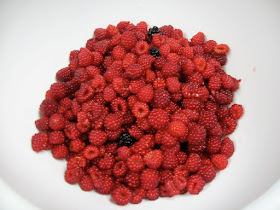 |
| Hey, a cucumber and some Thai basil ! |
So, in theory, next year my bed will be fabulous. This year, I was quite hosed. I added nitrogen, but this is a losing battle. The tomato plants responded by shooting up in height - skinny as a rail, but tall - and producing very limited flowers. My tiny tomatoes have produced a handful each, but the heirloom varieties haven't bloomed. Several plants never grew past a foot in height. This leaves me to buy from the market. Tomatoes are an expensive fruit, maybe the most expensive at the rate we can eat them. We'll easily devour a huge Brandywine - sliced and drizzled with olive oil, sprinkled with salt and pepper.
 |
| this tomato plant is so sadly skinny you can't tell it's 4' tall |
I've learnt though that cucumbers are less picky about their environment. In the past, I've successfully grown two cucumbers. Really. Two. But this year, the plants have done very well, or at least, in my perspective, very well. I have three varieties growing - two slicing and one pickling variety - and I've harvested over a dozen. Small cukes cover the vines and they seem to grow at a tremendous rate. The one thing I have found is that they can easily hide in the vegetation, so it's almost like a treasure hunt trying to find them. So, I'm looking at their success as a great step forward.
 |
| the cucumbers have been romping |
And, even though my veggies haven't been super successful, my flower beds this year are unbelievable. June was a particularly beautiful month, and the Fall bloomers are all setting themselves up for a great show. I have Japanese irises whose greens this year exceed 5', something I've never seen. And my English style, a.k.a. let the plants and the "weeds" fight it out themselves, has given off a crazy array of color. It's always hard to photo the garden, I think, because there always seems to be a lighting issue of some kind, but I've put a bunch of the plant photos on Picasa. The hydrangeas (I have more than 25 bushes) have almost all bloomed and are now changed to their deeper colors. I'm going to add some photos of them and the late bloomers as I can.
If you want to check them out, here they are: My Garden Photos
On an unrelated note, I have successfully convinced all of my neighbors to move their trash and recycling off of the storm drain. For fourteen years, our trash and recycling collection has been on this concrete pad at the bottom of the driveway. Inevitably every few weeks, trash would litter the entire area for one reason or another. That was bad enough, but one day a few years ago I actually looked at where we put things for collection. I mean, of course, I know where we put stuff, but I never saw that it was the storm drain leading directly into the Patapsco River. Of course, then I immediately noticed that the garbage didn't just litter the common property but tons of bottles and other trash would fall into the drain. There is no filter of any kind between the street and the river. I guess that's so it won't back up. This spring, I was able to organize our neighbors into a clean up, and they pulled some 13 garbage containers full of trash out of the stream. Perfect timing to propose we move the pick up. Only one neighbor resisted, but now several weeks later our road is no longer polluting that stream on mass. Yay!



















